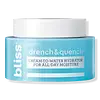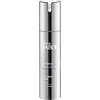What's inside
What's inside
 Key Ingredients
Key Ingredients

 Benefits
Benefits

 Concerns
Concerns

 Ingredients Side-by-side
Ingredients Side-by-side

Water
Skin ConditioningCyclopentasiloxane
EmollientGlycerin
HumectantButylene Glycol
HumectantDimethicone
EmollientHydrogenated Polyisobutene
EmollientSodium Acetylated Hyaluronate
HumectantSodium Hyaluronate
HumectantSodium Hyaluronate Crosspolymer
HumectantHyaluronic Acid
HumectantEthylhexylglycerin
Skin ConditioningDimethicone/PEG-10/15 Crosspolymer
Sodium Chloride
MaskingPhenoxyethanol
PreservativeBenzyl Alcohol
PerfumingSodium Citrate
BufferingDimethicone/Vinyl Dimethicone Crosspolymer
Skin ConditioningChamomilla Recutita Flower Extract
MaskingPassiflora Incarnata Seed Oil
Skin ProtectingPotassium Sorbate
PreservativeGuar Hydroxypropyltrimonium Chloride
Skin ConditioningPolysorbate 20
EmulsifyingDipropylene Glycol
HumectantTetrahexyldecyl Ascorbate
AntioxidantTocopheryl Acetate
AntioxidantSilybum Marianum Seed Oil
Skin ConditioningCaprylic/Capric Triglyceride
MaskingPorphyra Umbilicalis Extract
Skin ConditioningTocopherol
AntioxidantCommiphora Mukul Resin Extract
Skin ConditioningSaccharina Longicruris Extract
HumectantRosa Multiflora Fruit Extract
MaskingSodium Benzoate
MaskingLinalool
PerfumingAlpha-Isomethyl Ionone
PerfumingLimonene
PerfumingParfum
MaskingWater, Cyclopentasiloxane, Glycerin, Butylene Glycol, Dimethicone, Hydrogenated Polyisobutene, Sodium Acetylated Hyaluronate, Sodium Hyaluronate, Sodium Hyaluronate Crosspolymer, Hyaluronic Acid, Ethylhexylglycerin, Dimethicone/PEG-10/15 Crosspolymer, Sodium Chloride, Phenoxyethanol, Benzyl Alcohol, Sodium Citrate, Dimethicone/Vinyl Dimethicone Crosspolymer, Chamomilla Recutita Flower Extract, Passiflora Incarnata Seed Oil, Potassium Sorbate, Guar Hydroxypropyltrimonium Chloride, Polysorbate 20, Dipropylene Glycol, Tetrahexyldecyl Ascorbate, Tocopheryl Acetate, Silybum Marianum Seed Oil, Caprylic/Capric Triglyceride, Porphyra Umbilicalis Extract, Tocopherol, Commiphora Mukul Resin Extract, Saccharina Longicruris Extract, Rosa Multiflora Fruit Extract, Sodium Benzoate, Linalool, Alpha-Isomethyl Ionone, Limonene, Parfum
Water
Skin ConditioningGlycerin
HumectantSorbitol
HumectantPrunus Amygdalus Dulcis Oil
Skin ConditioningTocopheryl Acetate
AntioxidantHydrogenated Vegetable Glycerides
EmollientPanthenol
Skin ConditioningPhenoxyethanol
PreservativeDimethicone
EmollientPotassium Cetyl Phosphate
EmulsifyingCetearyl Alcohol
EmollientCocoglycerides
EmollientHydrogenated Palm Glycerides
EmollientUrea
BufferingTrehalose
HumectantCarbomer
Emulsion StabilisingXanthan Gum
EmulsifyingSodium Hyaluronate
HumectantEthylhexylglycerin
Skin ConditioningPentylene Glycol
Skin ConditioningSerine
MaskingDisodium EDTA
Sodium Hydroxide
BufferingAlcohol
AntimicrobialCaprylic/Capric Triglyceride
MaskingCaprylyl Glycol
EmollientGlyceryl Polyacrylate
Algin
MaskingDisodium Phosphate
BufferingPullulan
Pantolactone
HumectantPotassium Phosphate
BufferingAscorbyl Palmitate
AntioxidantTetradecyl Aminobutyroylvalylaminobutyric Urea Trifluoroacetate
Skin ConditioningCitric Acid
BufferingMagnesium Chloride
Ascorbic Acid
AntioxidantCI 42090
Cosmetic ColorantWater, Glycerin, Sorbitol, Prunus Amygdalus Dulcis Oil, Tocopheryl Acetate, Hydrogenated Vegetable Glycerides, Panthenol, Phenoxyethanol, Dimethicone, Potassium Cetyl Phosphate, Cetearyl Alcohol, Cocoglycerides, Hydrogenated Palm Glycerides, Urea, Trehalose, Carbomer, Xanthan Gum, Sodium Hyaluronate, Ethylhexylglycerin, Pentylene Glycol, Serine, Disodium EDTA, Sodium Hydroxide, Alcohol, Caprylic/Capric Triglyceride, Caprylyl Glycol, Glyceryl Polyacrylate, Algin, Disodium Phosphate, Pullulan, Pantolactone, Potassium Phosphate, Ascorbyl Palmitate, Tetradecyl Aminobutyroylvalylaminobutyric Urea Trifluoroacetate, Citric Acid, Magnesium Chloride, Ascorbic Acid, CI 42090
Ingredients Explained
These ingredients are found in both products.
Ingredients higher up in an ingredient list are typically present in a larger amount.
This ingredient is an emollient, solvent, and texture enhancer. It is considered a skin-softener by helping the skin prevent moisture loss.
It helps thicken a product's formula and makes it easier to spread by dissolving clumping compounds.
Caprylic Triglyceride is made by combining glycerin with coconut oil, forming a clear liquid.
While there is an assumption Caprylic Triglyceride can clog pores due to it being derived from coconut oil, there is no research supporting this.
Learn more about Caprylic/Capric TriglycerideDimethicone is a type of synthetic silicone created from natural materials such as quartz.
What it does:
Dimethicone comes in different viscosities:
Depending on the viscosity, dimethicone has different properties.
Ingredients lists don't always show which type is used, so we recommend reaching out to the brand if you have questions about the viscosity.
This ingredient is unlikely to cause irritation because it does not get absorbed into skin. However, people with silicone allergies should be careful about using this ingredient.
Note: Dimethicone may contribute to pilling. This is because it is not oil or water soluble, so pilling may occur when layered with products. When mixed with heavy oils in a formula, the outcome is also quite greasy.
Learn more about DimethiconeEthylhexylglycerin (we can't pronounce this either) is commonly used as a preservative and skin softener. It is derived from glyceryl.
You might see Ethylhexylglycerin often paired with other preservatives such as phenoxyethanol. Ethylhexylglycerin has been found to increase the effectiveness of these other preservatives.
Glycerin is already naturally found in your skin. It helps moisturize and protect your skin.
A study from 2016 found glycerin to be more effective as a humectant than AHAs and hyaluronic acid.
As a humectant, it helps the skin stay hydrated by pulling moisture to your skin. The low molecular weight of glycerin allows it to pull moisture into the deeper layers of your skin.
Hydrated skin improves your skin barrier; Your skin barrier helps protect against irritants and bacteria.
Glycerin has also been found to have antimicrobial and antiviral properties. Due to these properties, glycerin is often used in wound and burn treatments.
In cosmetics, glycerin is usually derived from plants such as soybean or palm. However, it can also be sourced from animals, such as tallow or animal fat.
This ingredient is organic, colorless, odorless, and non-toxic.
Glycerin is the name for this ingredient in American English. British English uses Glycerol/Glycerine.
Learn more about GlycerinPhenoxyethanol is a preservative that has germicide, antimicrobial, and aromatic properties. Studies show that phenoxyethanol can prevent microbial growth. By itself, it has a scent that is similar to that of a rose.
It's often used in formulations along with Caprylyl Glycol to preserve the shelf life of products.
Sodium Hyaluronate is hyaluronic acid's salt form. It is commonly derived from the sodium salt of hyaluronic acid.
Like hyaluronic acid, it is great at holding water and acts as a humectant. This makes it a great skin hydrating ingredient.
Sodium Hyaluronate is naturally occurring in our bodies and is mostly found in eye fluid and joints.
These are some other common types of Hyaluronic Acid:
Learn more about Sodium HyaluronateTocopheryl Acetate is AKA Vitamin E. It is an antioxidant and protects your skin from free radicals. Free radicals damage the skin by breaking down collagen.
One study found using Tocopheryl Acetate with Vitamin C decreased the number of sunburned cells.
Tocopheryl Acetate is commonly found in both skincare and dietary supplements.
Learn more about Tocopheryl AcetateWater. It's the most common cosmetic ingredient of all. You'll usually see it at the top of ingredient lists, meaning that it makes up the largest part of the product.
So why is it so popular? Water most often acts as a solvent - this means that it helps dissolve other ingredients into the formulation.
You'll also recognize water as that liquid we all need to stay alive. If you see this, drink a glass of water. Stay hydrated!
Learn more about Water